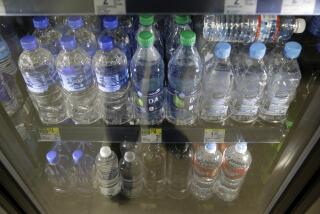Heat’s on plastic containers
Even amid the growing barrage of presumably well-intentioned health warnings now flying around cyberspace, this one is a doozy.
It warns that microwaving food in plastic containers releases dioxin, a carcinogen, or cancer-causing agent. The e-mail notes that the warning about dioxin had been sent out in a newsletter from Johns Hopkins, the esteemed medical institution in Baltimore, and that similar information is “being circulated” at Walter Reed Army Medical Center in Washington, D.C. The e-mail adds that freezing water in plastic bottles also releases dioxin.
Wrong, wrong, wrong. A Johns Hopkins spokesman called the e-mail a “hoax,” adding, “It was never in our newsletter.” A Walter Reed spokeswoman had never heard of it.
Put bluntly, there is “no dioxin in plastic, that’s absolutely crazy,” said George Pauli, associate director for science and policy at the office of food additive safety at the Food and Drug Administration. The FDA reviews all substances that are designed to come into contact with food, he said, noting that there is nothing in plastic food containers that appears to be a concern. “We would take action if there were.”
Moreover, dioxin is not water soluble, so even if there were dioxin in plastic containers, it would be more likely to stay in the plastic than dissolve in the water.
Obviously, dioxin is dangerous; it’s considered a human carcinogen. But the major dioxin exposure to humans comes not from plastic but from eating animal fat, said Dwain Winters, a policy analyst at the U.S. Environmental Protection Agency. Animals pick up dioxin by eating plants whose leaves acquire trace amounts of the chemical from the air, principally from combustion of fuels such as wood, coal or oil. Although environmental levels of dioxin have been declining through regulatory efforts since the 1970s, Winters said, most of us live with a small “body burden” of the chemical in our systems.
So do plastics used in food preparation get a totally clean bill of health? Not quite, but the risk is not something to lie awake worrying about.
Ana Soto, a professor of cell biology at Tufts University, said that certain clear, rigid plastics made with polycarbonates can release a substance called bisphenol A, a chemical that can mimic estrogen.
In her research, animal fetuses exposed to bisphenol A may show altered development of mammary glands. Bisphenol A, she added, can be released by heating or microwaving polycarbonate plastics, though there is no way for consumers to tell which plastics contain polycarbonates because this is not indicated on the containers.
Some baby bottles are made from polycarbonate plastic, noted Pauli of the FDA. But even when such bottles are heated in the microwave, FDA scientists have not been able to detect any bisphenol A residues in the milk or formula, suggesting the products are safe.
Bisphenol A can also leach out of the plastic lining put into metal food cans to prevent rust. Pauli said the agency has detected very low levels of bisphenol A in canned foods, but that this does not appear to pose a health hazard.
And what of the plastic cling wraps used to cover leftovers?
The filmy plastic sheets are made with “plasticizers,” chemicals that make the plastic more bendable. One such plasticizer, DEHA (diethylhexyl adipate) can leach out of cling wraps even without heating, Pauli said. The FDA has set standards for acceptable, safe levels of DEHA in plastic wraps based on studies of animals fed large quantities of the chemical.
Bottom line? Microwave food in glass, ceramic or plastic containers that are advertised (sometimes on packaging only) as safe for microwave use, advises the FDA. Do not microwave food in plastic containers such as margarine tubs, take-out containers or other products designed for one-time use -- this plastic can melt, possibly causing chemicals to migrate into food. If you microwave food in plastic wrap, to be on the safe side, don’t let the wrap touch the food during cooking.
If you still want to worry about microwaving, you can worry about this instead: The unevenness of cooking in a microwave leaves some undercooked cold spots that may still harbor bacteria.
More to Read
Sign up for Essential California
The most important California stories and recommendations in your inbox every morning.
You may occasionally receive promotional content from the Los Angeles Times.










